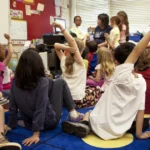Support our educational content for free when you buy through links on our site. Learn more
What Are the 5 Essential Teaching Strategies? 🎓 (2025)

Ever wondered what truly makes a classroom click? Whether you’re a fresh-faced teacher or a seasoned educator looking to refresh your toolkit, mastering the five essential teaching strategies can revolutionize your students’ learning experience. From tailoring lessons to individual needs with Differentiated Instruction to sparking curiosity through Inquiry-Based Learning, these strategies aren’t just buzzwords—they’re proven methods that transform engagement and outcomes.
Here’s a little teaser: did you know that classrooms using cooperative learning methods like the Jigsaw technique see significant boosts in student confidence and collaboration? Or that integrating technology smartly can turn even the most reluctant learners into eager participants? Stick around, because we’re diving deep into each strategy, sharing expert tips, real classroom stories, and how to blend these approaches for maximum impact.
Key Takeaways
- Differentiated Instruction adapts lessons to diverse student needs, boosting engagement and success.
- Cooperative Learning, especially the Jigsaw Method, fosters teamwork and peer teaching.
- Technology Integration keeps lessons interactive and relevant for digital natives.
- Inquiry-Based Instruction encourages critical thinking by letting students explore questions.
- Graphic Organizers help students visualize and organize complex information effectively.
Ready to equip your classroom with these game-changing strategies? Explore top-rated tools like Teaching Strategies GOLD® and ReadyRosie to support your teaching journey!
Table of Contents
- ⚡️ Quick Tips and Facts About Teaching Strategies
- 📚 The Evolution and Importance of Effective Teaching Methods
- 1. Differentiated Instruction: Tailoring Learning Stations for Every Student
- 2. Cooperative Learning: Mastering the Jigsaw Method for Collaborative Success
- 3. Harnessing Technology: Innovative Tools and Apps in Modern Classrooms
- 4. Inquiry-Based Instruction: Sparking Curiosity and Critical Thinking
- 5. Graphic Organizers: Visual Strategies to Boost Comprehension and Retention
- 🔍 Beyond the Basics: Additional Powerful Teaching Techniques You Should Know
- 🎯 How to Choose the Right Teaching Strategy for Your Classroom
- 📈 Measuring the Impact: Assessing the Effectiveness of Teaching Strategies
- 👩🏫 K-12 Resources Curated by Experienced Educators
- 🧩 Integrating Multiple Strategies for Maximum Engagement and Learning
- 💡 Tips and Tricks: Expert Advice for Implementing Teaching Strategies Successfully
- 🔚 Conclusion: Unlocking the Full Potential of Your Teaching Toolbox
- 🔗 Recommended Links for Further Exploration
- ❓ Frequently Asked Questions About Teaching Strategies
- 📚 Reference Links and Credible Sources
⚡️ Quick Tips and Facts About Teaching Strategies
Welcome to the ultimate guide on What are the five teaching strategies? At Teacher Strategies™, we’ve seen firsthand how the right approach can turn a chaotic classroom into a thriving learning hub. Before we dive deep, here are some quick nuggets to get you started:
- ✅ Differentiated Instruction meets students where they are, adapting lessons to diverse learning styles.
- ✅ Cooperative Learning builds teamwork and communication skills through group activities like the Jigsaw Method.
- ✅ Technology Integration keeps students engaged with tools like tablets, virtual field trips, and multimedia presentations.
- ✅ Inquiry-Based Instruction sparks curiosity by encouraging students to ask questions and explore topics deeply.
- ✅ Graphic Organizers help students visualize and organize information, boosting comprehension and retention.
Did you know? According to TeachHub, combining these strategies can improve student engagement and learning outcomes dramatically. But which one fits your classroom best? Stick around—we’ll unpack each in detail!
For more on instructional strategies, check out our Instructional Strategies category.
📚 The Evolution and Importance of Effective Teaching Methods
Teaching strategies didn’t just pop out of thin air—they evolved alongside educational research, technology, and cultural shifts. From the rigid, lecture-heavy classrooms of the past to today’s dynamic, student-centered environments, the journey has been fascinating.
Why do teaching strategies matter? Because no two students learn alike. As Howard Gardner’s Multiple Intelligences Theory reminds us, students bring unique strengths to the table. Effective strategies honor these differences, making learning accessible and meaningful.
Plus, with classrooms becoming more diverse, culturally responsive teaching has emerged as a vital approach. It integrates students’ cultural backgrounds into lessons, fostering inclusion and equity (Northeastern University).
So, whether you’re a newbie or a seasoned educator, understanding the evolution of teaching strategies helps you adapt and thrive in today’s classrooms.
1. Differentiated Instruction: Tailoring Learning Stations for Every Student
Differentiated Instruction is like having a custom-tailored suit for each student’s learning needs. It’s about recognizing that students vary in readiness, interests, and learning profiles—and adjusting your teaching accordingly.
What Are Learning Stations?
Learning stations are physical or virtual “zones” where students engage with tasks designed for different skill levels or learning styles. For example:
| Station Type | Activity Example | Learning Style Targeted |
|---|---|---|
| Reading Corner | Level-appropriate books | Linguistic, Visual |
| Math Manipulatives | Hands-on counting or puzzles | Kinesthetic |
| Tech Station | Educational apps or videos | Auditory, Visual |
| Creative Arts | Drawing or storytelling | Artistic, Interpersonal |
Benefits:
- Students work at their own pace ✅
- Encourages independence and responsibility ✅
- Supports diverse learning styles ✅
Drawbacks:
- Requires upfront planning and resources ❌
- Classroom management can be tricky if not structured well ❌
Our teacher Jane shares, “Learning stations transformed my classroom. Students who struggled with reading blossomed when they could choose activities that matched their interests.”
For practical tips on setting up stations, visit our Differentiated Instruction category.
2. Cooperative Learning: Mastering the Jigsaw Method for Collaborative Success
Cooperative learning is teamwork on steroids! It’s all about students working together to achieve shared goals, enhancing communication, problem-solving, and empathy.
The Jigsaw Method Explained
Imagine a puzzle where each student holds a unique piece. Each member becomes an “expert” on their piece and teaches it to their group. This method ensures accountability and values every voice.
Step-by-step Jigsaw:
- Divide the class into “home groups.”
- Assign each student a different segment of the lesson.
- Students meet in “expert groups” to master their segment.
- Return to home groups to teach peers.
- Assess understanding collaboratively.
Why it works:
- Builds interdependence ✅
- Boosts confidence and communication skills ✅
- Encourages active learning ✅
Potential challenges:
- Some students may dominate discussions ❌
- Requires clear instructions and monitoring ❌
Our educator Mike recalls, “At first, my shy students hesitated, but the Jigsaw gave them a platform to shine. It’s amazing how peer teaching deepens understanding.”
Explore more cooperative learning ideas in our Instructional Strategies section.
3. Harnessing Technology: Innovative Tools and Apps in Modern Classrooms
Technology isn’t just a buzzword—it’s a game-changer in education. From interactive whiteboards to tablets, tech tools can transform lessons and keep students hooked.
Popular Classroom Tech Tools
| Tool/App | Purpose | Benefits |
|---|---|---|
| Google Classroom | Assignment management | Streamlines communication |
| Kahoot! | Interactive quizzes | Engages students with gamification |
| Seesaw | Digital portfolios | Showcases student work |
| Nearpod | Interactive presentations | Real-time feedback |
| Flipgrid | Video discussions | Encourages student voice |
Benefits:
- Increases engagement and motivation ✅
- Supports diverse learning needs ✅
- Facilitates remote and hybrid learning ✅
Drawbacks:
- Requires reliable internet and devices ❌
- Can be distracting if not monitored ❌
Our tech-savvy teacher Lisa shares, “Using Kahoot! quizzes turned review sessions into competitions. Students begged for more!”
For a deep dive into tech integration, check out our Classroom Management category.
4. Inquiry-Based Instruction: Sparking Curiosity and Critical Thinking
Inquiry-based instruction flips the script: instead of feeding students answers, we invite them to ask questions and explore. It’s the “scientist in every student” approach.
How to Implement Inquiry-Based Learning
- Start with a question or problem: Make it relevant and open-ended.
- Guide exploration: Provide resources and tools, but let students lead.
- Encourage reflection: Have students share findings and connect ideas.
- Assess understanding: Use projects, presentations, or discussions.
Why it rocks:
- Develops critical thinking and problem-solving ✅
- Fosters ownership of learning ✅
- Prepares students for real-world challenges ✅
Challenges:
- Can be time-consuming ❌
- Requires teacher flexibility and patience ❌
Our colleague Sarah says, “When students investigate their own questions, their enthusiasm is contagious. It’s messy but worth every minute.”
For more on inquiry methods, visit our Lesson Planning category.
5. Graphic Organizers: Visual Strategies to Boost Comprehension and Retention
If you’ve ever tried to untangle a knot, you know how helpful a visual guide can be. Graphic organizers do just that for learning—they help students map out ideas clearly.
Popular Types of Graphic Organizers
| Organizer Type | Purpose | Best For |
|---|---|---|
| Venn Diagram | Comparing and contrasting | Literature, science |
| Concept Map | Showing relationships | Complex topics |
| KWL Chart | What students Know, Want to know, Learned | Activating prior knowledge |
| T Chart | Pros and cons or facts and opinions | Decision making |
Benefits:
- Simplifies complex information ✅
- Supports diverse learners ✅
- Enhances memory and recall ✅
Drawbacks:
- May feel restrictive if overused ❌
- Requires initial teaching on how to use effectively ❌
Our teacher Mark notes, “Graphic organizers turned my reluctant writers into confident planners. They see their ideas come alive on paper.”
Explore more visual tools in our Instructional Coaching category.
🔍 Beyond the Basics: Additional Powerful Teaching Techniques You Should Know
While the five strategies above are foundational, the teaching world is rich with other methods worth exploring:
- Culturally Responsive Teaching: Embracing students’ cultural backgrounds to make learning relevant and inclusive (Northeastern University).
- Flipped Classroom: Students learn new content at home and apply it in class, maximizing interaction.
- Formative Assessment: Ongoing checks for understanding to tailor instruction in real time.
- Project-Based Learning: Students work on extended projects that integrate multiple skills and subjects.
Each technique has its place and can be blended with the five core strategies for a richer learning experience.
🎯 How to Choose the Right Teaching Strategy for Your Classroom
Choosing the perfect strategy isn’t a one-size-fits-all deal. Here’s a quick decision guide:
| Factor | Strategy to Consider | Why? |
|---|---|---|
| Diverse learning styles | Differentiated Instruction | Meets individual needs |
| Building teamwork | Cooperative Learning | Develops social skills |
| Tech-savvy students | Technology Integration | Engages digital natives |
| Encouraging curiosity | Inquiry-Based Instruction | Promotes deep understanding |
| Visual learners | Graphic Organizers | Simplifies complex info |
Remember, the best teachers mix and match strategies based on their students’ needs and lesson goals. Don’t hesitate to experiment and reflect on what works best!
📈 Measuring the Impact: Assessing the Effectiveness of Teaching Strategies
How do you know if your chosen strategy is hitting the mark? Here are some key indicators:
- Student Engagement: Are students actively participating and showing interest?
- Learning Outcomes: Are test scores, projects, or presentations improving?
- Feedback: What do students say about their learning experience?
- Classroom Atmosphere: Is there a positive, collaborative vibe?
Use tools like exit tickets, surveys, and observation checklists to gather data. Remember, some strategies take time to show results, so patience is key.
👩🏫 K-12 Resources Curated by Experienced Educators
At Teacher Strategies™, we believe in empowering educators with practical, research-backed resources. Here are some top picks:
- Teaching Strategies GOLD®: A comprehensive assessment system for early childhood education (Official Site).
- ReadyRosie: Family engagement platform that supports learning at home (ReadyRosie Official).
- Tadpoles: Classroom management and communication tool (Tadpoles Official).
These tools complement teaching strategies by providing data, communication, and engagement support.
🧩 Integrating Multiple Strategies for Maximum Engagement and Learning
Why settle for one when you can blend several? For example, combine Differentiated Instruction with Technology Integration by using adaptive learning apps tailored to student levels. Or pair Cooperative Learning with Graphic Organizers to help groups plan and present ideas visually.
Pro tip: Start small—introduce one new strategy at a time and observe. Over time, layering strategies creates a dynamic, responsive classroom.
💡 Tips and Tricks: Expert Advice for Implementing Teaching Strategies Successfully
- Plan Ahead: Preparation is your best friend. Map out how and when you’ll use each strategy.
- Set Clear Expectations: Students thrive when they know what’s expected during activities like learning stations or group work.
- Be Flexible: If something isn’t working, tweak it! Teaching is an art, not a science.
- Reflect and Adjust: Keep a teaching journal or use peer observations to refine your approach.
- Engage Families: Share your strategies with parents to reinforce learning at home.
Remember, as one of our veteran teachers puts it, “Teaching is a journey of trial, error, and triumph. Celebrate the wins, learn from the misses, and keep evolving.”
For a quick visual refresher, don’t miss the engaging video “What Are The Five Teaching Strategies?” by Childhood Education Zone, linked above in the article (#featured-video). It’s a great primer that complements everything we’ve covered here!
🔚 Conclusion: Unlocking the Full Potential of Your Teaching Toolbox
So, what are the five teaching strategies that can transform your classroom? We’ve unpacked Differentiated Instruction, Cooperative Learning, Technology Integration, Inquiry-Based Instruction, and Graphic Organizers—each a powerful tool in its own right. But here’s the secret sauce: the magic happens when you blend them thoughtfully to meet your students’ unique needs.
From our experience at Teacher Strategies™, these methods don’t just improve academic outcomes—they foster curiosity, collaboration, and confidence. Remember Jane’s story about learning stations unlocking her students’ potential? Or Mike’s testimony on the Jigsaw Method empowering shy learners? These aren’t just theories; they’re classroom realities.
While no strategy is perfect—each requires planning, patience, and flexibility—the benefits far outweigh the challenges. The key is to start small, observe, and adapt. Your students will thank you with engagement, growth, and enthusiasm.
And if you’re wondering which to try first, consider your classroom’s current needs and strengths. Need to boost collaboration? Start with cooperative learning. Want to engage tech-savvy students? Dive into technology integration. The possibilities are endless!
Ready to level up your teaching game? Let’s get strategizing! 🚀
🔗 Recommended Links for Further Exploration
Looking to equip your classroom with the best resources and deepen your understanding? Here are some top picks:
-
Teaching Strategies GOLD® Assessment System:
Amazon Search: Teaching Strategies GOLD | Teaching Strategies Official -
ReadyRosie Family Engagement Platform:
Amazon Search: ReadyRosie | ReadyRosie Official -
Tadpoles Classroom Management Software:
Amazon Search: Tadpoles | Tadpoles Official -
Books on Teaching Strategies:
- “The Differentiated Classroom: Responding to the Needs of All Learners” by Carol Ann Tomlinson — Amazon
- “Cooperative Learning: Theory, Research, and Practice” by Robert E. Slavin — Amazon
- “Inquiry and the National Science Education Standards” by National Research Council — Amazon
- “Graphic Organizers for Reading Comprehension” by Jennifer Serravallo — Amazon
❓ Frequently Asked Questions About Teaching Strategies What are the most effective teaching strategies for student success?
The most effective strategies are those that address diverse learning needs, engage students actively, and foster critical thinking. Differentiated instruction, cooperative learning, inquiry-based instruction, technology integration, and graphic organizers have all been shown to improve understanding and retention. Combining these approaches creates a dynamic learning environment that supports academic and social growth.
How can teachers implement the five teaching strategies in the classroom?
Implementation starts with planning and understanding your students’ needs. For differentiated instruction, create learning stations with varied tasks. Use the Jigsaw Method to promote cooperative learning. Integrate technology tools like Kahoot! or Google Classroom to enhance lessons. Encourage inquiry by posing open-ended questions and guiding exploration. Finally, incorporate graphic organizers to help students visualize concepts. Start small, model expectations, and adjust based on feedback.
What are examples of active learning strategies for teachers?
Active learning includes techniques that require students to participate actively rather than passively absorb information. Examples include:
- Think-pair-share
- Problem-based learning
- Role-playing
- Peer teaching (like the Jigsaw Method)
- Interactive quizzes (using tools like Kahoot!)
These strategies increase engagement and deepen understanding by involving students directly in the learning process.
How do the five teaching strategies improve student engagement?
Each strategy taps into different motivators:
- Differentiated instruction respects individual interests and readiness.
- Cooperative learning builds social connections and accountability.
- Technology appeals to digital natives and offers interactive content.
- Inquiry-based learning satisfies natural curiosity.
- Graphic organizers simplify complex ideas visually.
Together, they create a varied and stimulating environment that keeps students invested.
What role do collaborative learning strategies play in classroom success?
Collaborative learning, such as the Jigsaw Method, fosters communication, empathy, and shared responsibility. It helps students learn from peers, develop social skills, and build confidence. Research shows that students in cooperative settings often outperform those in traditional lectures, especially in problem-solving and critical thinking.
How can differentiated instruction be used as a teaching strategy?
Differentiated instruction involves tailoring content, process, and products to students’ varying abilities and interests. Teachers can use flexible grouping, varied assignments, and learning stations to meet individual needs. It requires ongoing assessment and adjustment but results in more personalized and effective learning experiences.
What are the benefits of using varied teaching strategies in education?
Varied strategies address diverse learning styles, keep lessons fresh, and prevent boredom. They promote higher-order thinking, social skills, and adaptability. Using multiple approaches also prepares students for real-world challenges by developing a broad skill set.
How does culturally responsive teaching complement the five teaching strategies?
Culturally responsive teaching (CRT) integrates students’ cultural backgrounds into learning, making content relevant and inclusive. CRT enhances engagement and equity, complementing strategies like differentiated instruction and cooperative learning by validating diverse perspectives and experiences.
📚 Reference Links and Credible Sources
- TeachHub: Top 5 Teaching Strategies
- Northeastern University: Culturally Responsive Teaching Strategies
- Teaching Strategies: Science of Reading eBook
- Howard Gardner’s Multiple Intelligences Theory: Edutopia
- ReadyRosie Official Website: https://www.readyrosie.com/
- Tadpoles Official Website: https://www.tadpoles.com/
- Teaching Strategies Official Website: https://teachingstrategies.com/
We hope this comprehensive guide has answered your burning questions and inspired you to experiment with these five teaching strategies. Remember, the best teaching strategy is the one that fits your unique classroom and sparks joy in learning! 🌟







